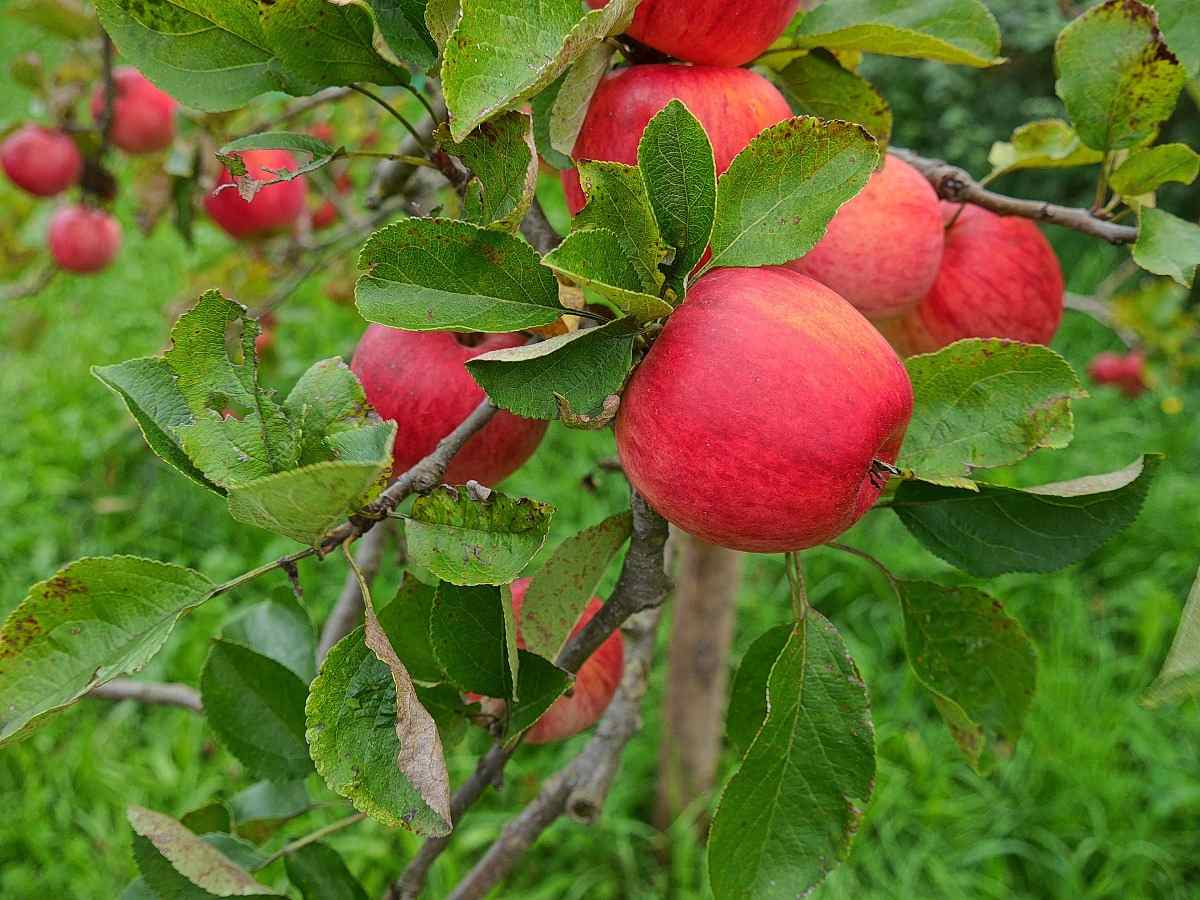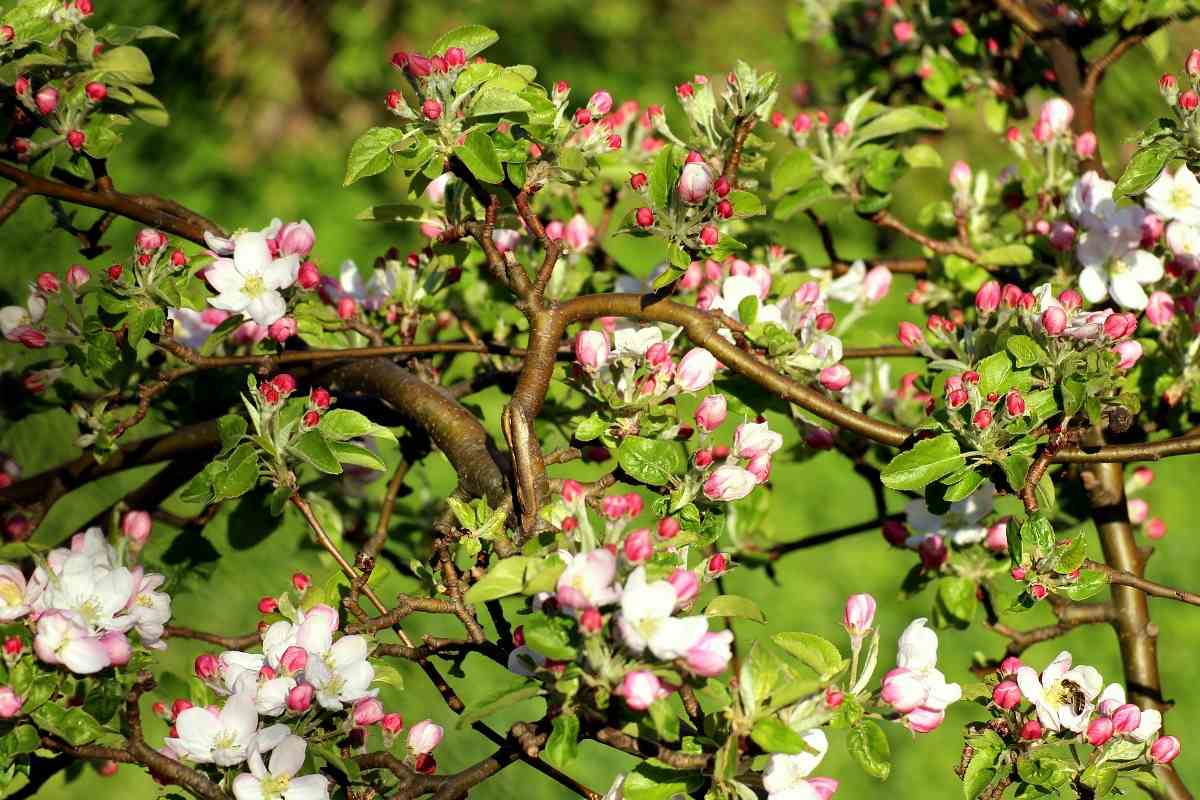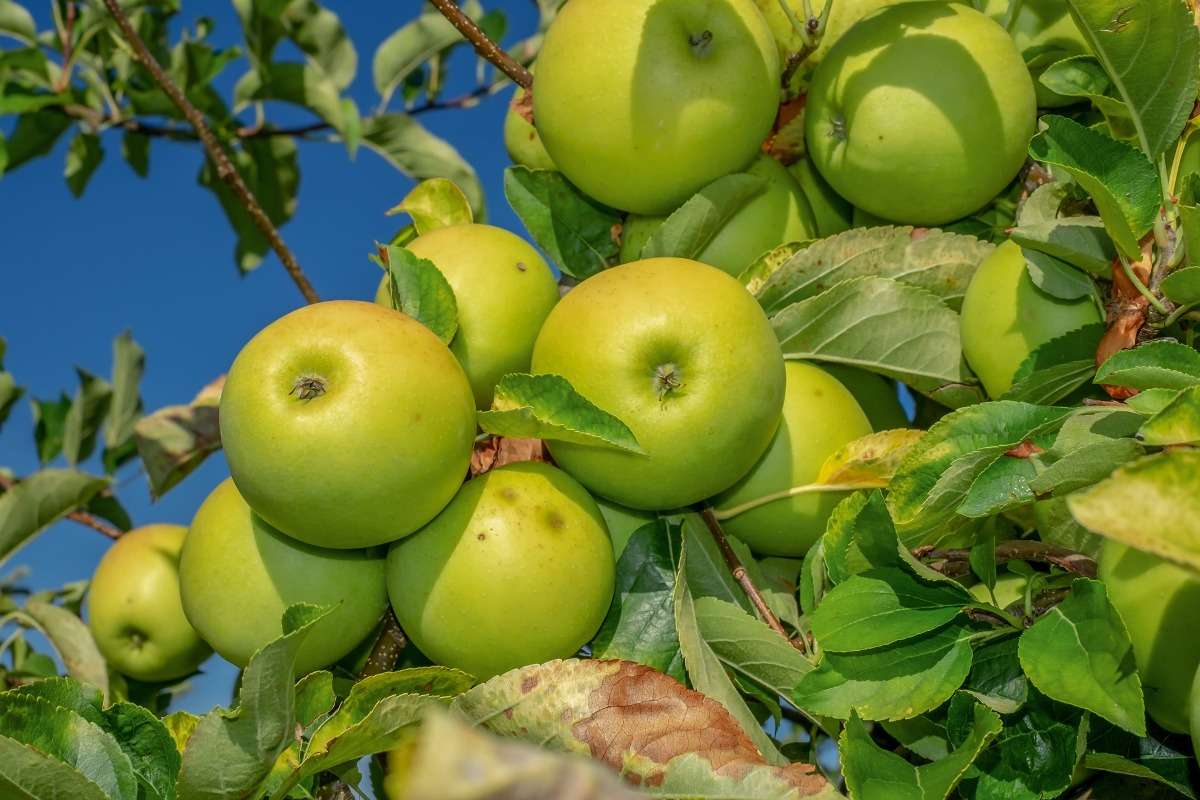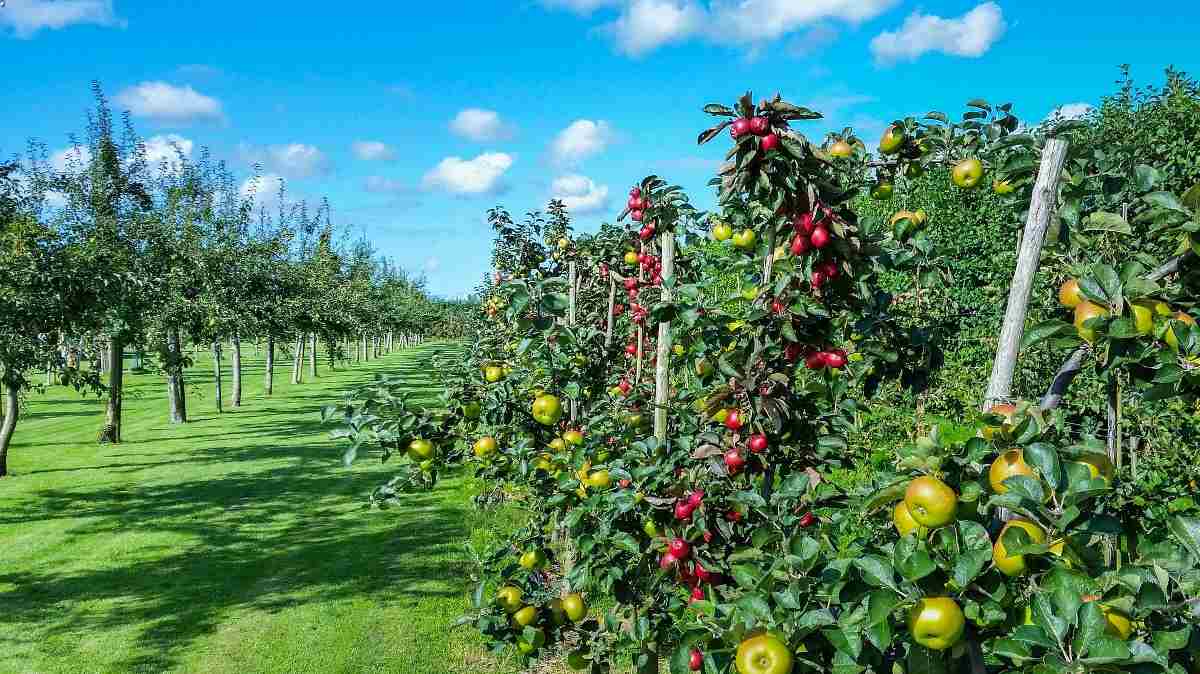Introduction to Apple tree pests and diseases
Apple tree is a deciduous tree in the family Rosaceae which is grown for its fruits, known as apples. Apple fruits are one of the most widely cultivated fruits in the world. When planted from a seed, an apple tree can take 6 to 10 years to mature and produce the fruit of its own. Apple trees are small to medium-sized trees reaching heights of 5 to 10 m, with a central trunk which divides into several branches. The leaves of the Apple tree are oval and can reach up to 13 cm (5.1 in) in length and 7 cm in width.
Apple fruit is a delicious fruit that unfortunately does not attract only humans. Aphids, maggots, beetles, leafhoppers, mites, and thrips attack the apple tree to lay their eggs and be fed. The common denominator of these pests is that they lay their eggs in different parts of the tree or the fruit and they cause spots or holes to the fruit, fruit drop, and damage to the leaves. They can cause curling and yellowing to plant leaves, skeletonization, and defoliation. Now, let’s get into the details of Apple tree diseases and pests and their control measures.
A guide to Apple tree pests, diseases, and their control
Coddling Moth
Maggoty apples, usually the earlier varieties, are identified as Coddling Moth. The small adult moths lay their eggs on developing fruit in May and June and the tiny larvae burrow into the developing fruitlets and feed inside. They then emerge to pupate in the bark of the apple tree and overwinter there before emerging in late spring to continue the cycle all over again. Pheromone traps could help capture adult moths in the spring.
Aphids of Apple tree pests and diseases
You usually first notice the presence of aphids or greenfly by distorted and yellow new growths. Closer inspection will reveal a thick cluster of these tiny insects underneath the leaves and on the stems. They can be controlled by ‘bug gun’ systemic insecticide, biological controls, and even soapy water. Sometimes if the problem is not noticed soon enough the shoots can be so badly affected they must be cut off and destroyed. It is important to control these insects not only because they debilitate and weaken the apple tree; they also spread virus and disease.
In case if you miss this: Lemon Flower and Fruit Drop, Causes and Control Methods.

Woolly aphids
They are more difficult to control and usually contact insecticides do not touch them. Try to use a systemic insecticide or biological control. It is said that painting methylated spirits onto affected shoots can deter them. A good winter wash could help eradicate overwintering populations.
Capsid Bugs
Will manifest themselves by tattered tree leaves and lumpy malformed fruit as the adults feed not only on foliage but also young immature fruit. They could be controlled by insecticides. Malformed lumpy fruits can be the result of frosts or hailstones present when the fruits are young.
Protect Apple trees from pests
Pests can spread problems quickly over a single tree or throughout an entire orchard of healthy apple fruit producers. There are a few maintenance procedures to follow the apple trees growing season to keep disease-spreading bugs at bay. Before new leaves emerge in spring, spray the apple trees with nontoxic horticultural oil that will smother the dormant insects along with their clusters of minuscule eggs.
Around early- to mid-summer is a prime bug-breading season and this is also the best time to control the insects with organic insecticides to stop them from mating and laying eggs on or near the budding fruit. Pests that attack apple trees and damage fruit and leaves contain the codling moth, maggot flies, and plum curculio.
Diseases and their control in Apple trees
The main apple diseases are;
The main apple diseases, common in many areas of the country, are apple scab, cedar apple rust, powdery mildew, and fire blight. Hopefully, you’ve chosen cultivars (cultivated varieties) resistant to some or all of these, for example ‘Freedom’ or ‘Liberty’. Other cultivars could tolerate these diseases, so you still won’t have to spray. If looking to buy some trees from a local nursery to plant, check for their disease resistance. Other diseases you could see on apples are black rot and bitter pit.
Apple scab of Apple tree pests and diseases
Apple scab is the most common disease in Apple trees. It is one of the most serious diseases that afflict apple trees. It appears in early to mid-spring and is more prevalent during rainy weather. The disease is mainly caused by the fungus Venturia inqequalis, which overwinters in infected leaves left on the ground. The fungus spores are released in the spring during wet weather and are blown by the wind onto vulnerable, newly emerging plant leaves.
Symptoms of Apple scab disease – Yellow or chlorotic spots on plant leaves; dark olive-green spots on leaves and fruit; maybe a velvety growth on spots on undersides of tree leaves; twisting of leaves; distorted leaves; severely infected leaves turn yellow and drop from Apple tree. This fungus causes olive-colored and velvety splotches on leaves and dark unsightly blotches on Apple fruits. Fruits infected early in the season can fall off, and those infected later often aren’t fit to eat. This is mainly a problem in rainy and wet seasons. Other than dormant oil sprays in early spring, and fungicide sprays beginning in spring, keeping fallen leaves and fruit picked up in fall will help to prevent this disease.
Management – Remove all leaves dropped from Apple tree in the fall and compost to prevent any diseases surviving in debris; application of zinc and fertilizer grade urea in the Fall can be necessary to speed leaf drop, lime must then be added to fallen leaves; fungicide application may be necessary for areas where leaves remain wet for periods over 9 hours; fungicides such as copper soaps and Bordeaux mixture must be applied if there is a chance of wet period as soon as leaf tips emerge.
Several apple tree varieties, including Jonafree, Liberty, Enterprise, Pristine, and Williams Pride are completely resistant to apple scab. Choose scab resistant varieties, particularly if apple scab is a frequent problem in your area. Avoid Red Delicious, Cortland, McIntosh, and Rome Beauty, which are all susceptible to the Apple scab disease. Promptly rake up and remove leaves and debris in the fall and spray susceptible trees with fungicide in early spring, for example, lime sulfur, sulfur, or Captan.
Cultural control – Use resistant plant varieties if available. Prune so the apple tree has good light and air penetration and branches are not too close together. Rake up and burn the old plant leaves each fall.
Chemical control – Fungicide sprays are needed throughout the growing season for most apple tree varieties to produce healthy fruit.
You should not miss the Basic Steps of Organic Farming, Organic Farming Types.

Cedar apple rust
Symptoms of cedar-apple rust disease – Bright orange or yellow patches on the top side of the tree leave surrounded by a red band and small black spots in the center; by mid-summer, cup-like structures called aecia to form on the leaf undersides; these covered in tubular structures from which spores are released.
Management –Several rust diseases attack leaves and fruit of apple trees, with cedar apple rust being the worst. As its name indicates, it makes rusty spots on tree leaves and attacks cedars too (and needs them to complete its life cycle). Remove cedars and junipers from within a few hundred feet and you can eliminate this disease.
Powdery mildew of Apple tree pests and diseases
Powdery mildew is mainly caused by the fungus Podosphaera leucotricha and develops first as white, felt-like growths on the undersides of leaves. As the disease spreads, it causes wilted leaves, stunted growth, and black pinpoint specks on the tree leaves and twigs. Avoid susceptible tree varieties, including Granny Smith, Jonathan, Rome, and Cortland. Plant the Apple trees in full sun and allow plenty of space between them for good air circulation. Spray the Apple trees in early spring with Myclobutanil, lime sulfur, or sulfur.
Symptoms – White velvety patches on the underside of plant leaves; chlorotic spots on the top side of the leaves
Management – Apply sprays at the pink bud stage to reduce the build-up; organic treatments contain the application of lime and sulfur.
Cultural control – Rake and remove fallen leaves.
Chemical control – Fungicides are necessary for most apples to produce a healthy crop. Then, sprays are applied to start in the early flower bud stage until mid-summer.
Fire blight
Trees infected with fire blight could have water-stained, brown blossoms and brown leaves. The twigs and the branches of the tree can turn brown or black and have open cankers that ooze a thick, brown liquid. The twigs may turn downward at the tips to resemble a shepherd’s crook. The fire blight disease overwinters in infected wood and is spread in the spring through rain and insects.
Symptoms – Plant appears as if it has been scorched by fire; watery exudates can be present on infected areas.
Management – Cut out diseased wood and treat with Bordeaux mixture; copper application to blossoms can be necessary to prevent spread.
Cultural control – Use varieties of apple trees that tolerate or resist fire blight. Use enough fertilizer to give good steady growth. Prune out shoots with blight during the dormant season. Cut at least 6 inches below any sign of dead or discolored wood. Clean pruning tools between each cut.
Chemical control – Carefully apply the Bordeaux mixture before bud break.
You may also like the Apple Fruit Drop Causes, Factors, Control Methods.

Crown rot of Apple tree pests and diseases
Crown rot disease is caused by the same fungus that causes Phytophthora rot but causes decay at the trees’ roots or crown. Disease symptoms include delayed bud break, leaf and bark discoloration, and twig dieback. Carefully remove some of the soil from the plant roots, taking care not to injure the tree. Scrape away the outer bark to reveal interior wood that is reddish-brown and water-soaked, confirming that the apple tree is infected with crown rot. There is no cure for crown rot and the apple tree will likely eventually die. Plant apple trees in areas with good drainage, as recommended previously. Commercially grown apples are subject to a variety of chemical treatments because apples are prone to so many diseases and pests.
Apple mosaic and other virus diseases
Disease symptoms – Apple trees infected with apple mosaic virus develop pale to bright cream spots on spring leaves as they expand. These spots can become necrotic after exposure to summer sun and heat.
Other viral diseases are symptomless in most commercial cultivars, but cause symptoms in certain cultivars, rootstock combinations, and ornamental varieties. Symptoms of apple chlorotic leaf spot virus can include chlorotic leaf spots, leaf distortion, chlorotic rings and line patterns, reduced leaf size, and stunting.
Apple stems grooving virus produces symptoms on ‘Virginia Crab’ for example chlorotic leaf spots, stern grooving and pitting, union necrosis, and swelling of the stem above the graft union.
Flyspeck
Symptoms – Shiny black fungal fruiting bodies appear as dots arranged in irregular to the circular pattern on the Apple fruit surface.
Management – Prune trees to open canopy and promote drying of fruit surface; fungicides can be applied as a preventative measure.
Black rot of Apple tree pests and diseases
This Black rot disease is caused by a fungus that grows on many woody plants and trees and is spread by wind. Leaves could have many large brown spots that start round and become patches as they grow together. The spots are dry and like paper. Spots on fruit can appear any time during the season and infected fruit rot and hang on the tree. The fungus causes cankers on branches.
Symptoms – Purple flecks or circular lesions are brown in the center and purple at the margin; red flecks, purple lesions, and brown-black rings on fruit.
Management – Remove dead wood, mummified fruit, and cankers from apple trees to reduce the spread of disease; burn any pruning that has been made from the apple tree; the disease can be controlled by fungicides from silvertip to harvest.
Cultural control – Prune out and burn tree branches with cankers and deadwood. Prune to open up the tree for good air movement and remove dead fruit from the apple tree each fall.
Chemical control – Probably not required in dry climates.
Phytophthora crown and root rot
Symptoms – Leaves wilting but remain attached to the Apple tree; reduced growth; early senescence; cankers at soil level, a dark discoloration of bark which is slimy when wet.
Management – Practice good water management to prevent the emergence of root rot disease; do not over-water trees or allow water to accumulate in the soil.
Cork spot of Apple tree pests and diseases
Cork spot may resemble hail or insect damage but is caused by low soil pH level and subsequent calcium deficiency. The disease appears as small dimples on the skin of developing apple fruits. The dimples spread to about ½-inch wide and may appear corky or soft. The apple fruit is edible, but the spots reduce its aesthetic appeal.
Add lime to the soil, according to the recommendations of a soil test analysis, if the pH level of your soil falls below 6.0. Spray the trees with calcium chloride at a rate of about 1.5 tablespoons of calcium chloride per gallon of water per tree. Make four applications, beginning immediately after full bloom, and reapply the solution every ten days to help control the cork spot.
Best organic options for controlling apple tree diseases
You have some methods to beat back difficult diseases that take over apple trees. Two major organic farming techniques are;
Sprays – Serious diseases such as fire blight and apple scab that can take down healthy apple trees quickly contain dormant oil sprays, such as a liquid copper soap or Bordeaux mixture. Many of these organic sprays can take out other diseases that creep along unnoticed until it is too late. They won’t hurt the apple tree when done correctly at the right time within the growing season.
Solar – Before planting a single tree or a crop of young apple trees, allow the sun to bake the soil and kill off soil-borne pathogens. The temperature needs to hover around 100F at minimum to let the solar solution work. Cover the soil with sheets of plastic and allow the sun to bake the ground for about 2 to 4 weeks before you plan to plant.
Commonly asked questions about growing Apple trees

Why are the leaves on the apple tree curling up?
Powdery mildew fungus can cause the leaves of your apple tree to curl or be distorted, but you also would see a powdery film or residue on the leaves if this is the case.
How many years does it take for an apple tree to grow?
A seedling of any apple variety will grow into a tree from 12 to 20 feet high and take 6 to 10 years to bear apples. You can reduce the size of an apple tree and shorten its bearing time by planting specially developed rootstocks with a grafted scion of the apple variety you want.
Why does apple tree look like its dying?
Collar rot disease is a particularly bad apple tree problem. Initially, it will cause stunted or delayed growth and blossoming, yellowing tree leaves, and leaf drop. Eventually, a canker (dying area) will appear at the base of the tree, girdling and killing the Apple tree.
Why is apple tree wilting?
The main cause of apple tree wilting is the inadequate application of water. When an apple tree needs water but there isn’t enough to meet this need, drought stress occurs, causing yellowing and wilting of the plant leaves, early defoliation, and premature ripening or dropping of the fruit.
Why are the leaves dying on an apple tree?
Apple trees can suffer damage to their fruit, branches, and leaves due to disease, insect pests, environmental conditions, and nutrient deficiencies. The symptom of browning of the edges on apple tree leaves is associated with drought, salt injury, potassium, or magnesium deficiency.
Why are the leaves on the apple tree turning yellow?
Apple trees normally have glossy, medium green leaves. When leaves turn yellow, either the weather has turned cold or the apple tree is suffering from some sort of disease and nutritional deficiencies. Over time, these can result in the yellowing of large numbers of plant leaves, known as chlorosis.
Why are the leaves on the apple tree turning brown?
Fire blight disease often attacks open flowers first, which results in brown flowers and stems. Following this, the leaves turn brown and then black and remain on the apple tree throughout the dormant season.
Conclusion of Apple tree pests and diseases
If you are growing Apples commercially, you must be aware of possible and common Apple tree diseases and pests along with thier control methods for healthy tree growth and quality produce of yield. You may also check the Dragon Fruit Seed Germination, Time Period, Process.